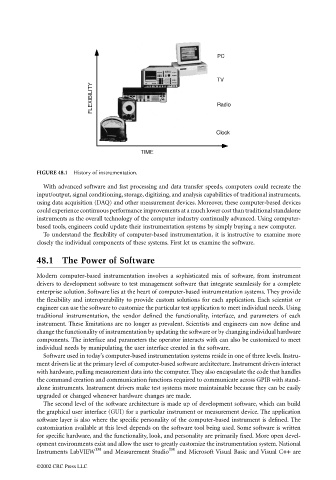Page 1203 - The Mechatronics Handbook
P. 1203
FIGURE 48.1 History of instrumentation.
With advanced software and fast processing and data transfer speeds, computers could recreate the
input/output, signal conditioning, storage, digitizing, and analysis capabilities of traditional instruments,
using data acquisition (DAQ) and other measurement devices. Moreover, these computer-based devices
could experience continuous performance improvements at a much lower cost than traditional standalone
instruments as the overall technology of the computer industry continually advanced. Using computer-
based tools, engineers could update their instrumentation systems by simply buying a new computer.
To understand the flexibility of computer-based instrumentation, it is instructive to examine more
closely the individual components of these systems. First let us examine the software.
48.1 The Power of Software
Modern computer-based instrumentation involves a sophisticated mix of software, from instrument
drivers to development software to test management software that integrate seamlessly for a complete
enterprise solution. Software lies at the heart of computer-based instrumentation systems. They provide
the flexibility and interoperability to provide custom solutions for each application. Each scientist or
engineer can use the software to customize the particular test application to meet individual needs. Using
traditional instrumentation, the vendor defined the functionality, interface, and parameters of each
instrument. These limitations are no longer as prevalent. Scientists and engineers can now define and
change the functionality of instrumentation by updating the software or by changing individual hardware
components. The interface and parameters the operator interacts with can also be customized to meet
individual needs by manipulating the user interface created in the software.
Software used in today’s computer-based instrumentation systems reside in one of three levels. Instru-
ment drivers lie at the primary level of computer-based software architecture. Instrument drivers interact
with hardware, pulling measurement data into the computer. They also encapsulate the code that handles
the command creation and communication functions required to communicate across GPIB with stand-
alone instruments. Instrument drivers make test systems more maintainable because they can be easily
upgraded or changed whenever hardware changes are made.
The second level of the software architecture is made up of development software, which can build
the graphical user interface (GUI) for a particular instrument or measurement device. The application
software layer is also where the specific personality of the computer-based instrument is defined. The
customization available at this level depends on the software tool being used. Some software is written
for specific hardware, and the functionality, look, and personality are primarily fixed. More open devel-
opment environments exist and allow the user to greatly customize the instrumentation system. National
TM TM
Instruments LabVIEW and Measurement Studio and Microsoft Visual Basic and Visual C++ are
©2002 CRC Press LLC

